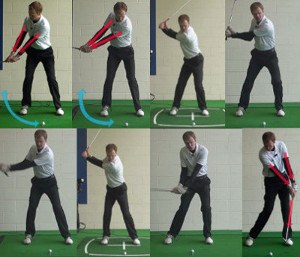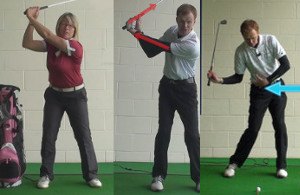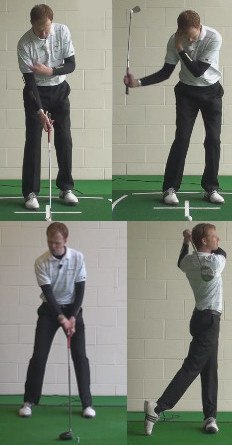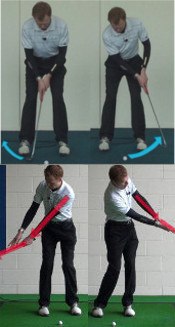One of the biggest advantages to a connected swing, and one of the main reasons why it is so important to work on this point, is the consistency that you can gain through staying connected. As you already know, it is crucial to move the club around your body in the same manner time after time, all day long. If there are extra moving parts in your swing that don't contribute to the overall goal of sending the ball toward the target, those parts will lead to unwanted inconsistency. Boiling your swing down to its most basic parts is something that all golfers should be trying to do, and staying connected plays a role in that process. A connected swing looks simple and even 'easy' – which is exactly what you want.

Don't make the mistake of thinking that a connected swing is one which lacks power, either. While the swing might look controlled from start to finish, it can still contain plenty of power when executed correctly. You will be able to use your entire body to put power into the shot when you stay connected, meaning there is likely to be more speed in the swing than it may appear from the outside. The great thing about this kind of power is that you should be able to control it as well – power that comes from a disconnected swing is usually wild and out of control, meaning it is useless to you on the course. Focus on learning how to stay connected and the power that you do produce will be used to send the ball directly down the middle of the fairway.
| GOLF FIXES BY PGA PROS |
|---|
| Common Problems For Senior Golfers Related To Connected Backswing | Video | Article |
| Stay Connected In Golf | Video | Article |
| What is a Connected Golf Swing, Will it Help with Accuracy and Distance | Video | Article |
| How To Stay Connected And On Plane In The Golf Backswing | Video | Article |
| Golf Arms Staying Connected To Your Body | Video | Article |
| How to Create a Connected Golf Swing as a Senior Golfer | Video | Article |
| Keep Connected For Good Golf Swing Plane | Video | Article |
| Golf Fix: Take the Club Back Low and Slow For Correct Connected Swing | Video | Article |
| Low And Slow for Connected Backswing | Video | Article |
| LESSONS |
|---|
| Key Points Of A Connected Golf Swing | Video | Article |
| Low And Slow For Connected Golf Backswing | Video | Article |
| How and Why: A Proper Connected Golf Swing Creates Improved Accuracy and Distance | Video | Article |
| Mechanics to Create a Connected Golf Swing | Video | Article |
| Short Game Concepts For A Connected Golf Backswing | Video | Article |
| Connected Golf Swing | Video | Article |
| Techniques for a connected golf swing | Video | Article |
| The Mechanics Of A Connected Golf Swing | Video | Article |
| Elements Of A Connected Golf Swing | Video | Article |
| What Is A Connected Golf Swing | Video | Article |
| Gain More Power With A Connected Golf Swing | Video | Article |
| Improve Tempo With A Connected Golf Swing | Video | Article |
| Key Points Of A Connected Golf Swing | Video | Article |
| Learning The Connected Transition In The Golf Swing | Video | Article |
| Loading The Shaft In Connected Golf Swing | Video | Article |
| How Best to Create a Connected Women Golf Swing | Video | Article |
| PRACTICE DRILLS |
|---|
| A Simple Drill For Connected Golf Backswing | Video | Article |
| GOLF QUESTIONS |
|---|
| Connected Golf Swing, What Is It How Can I Develop One | Video | Article |
| Connected Golf Swing, What Should I Feel? | Video | Article |
When talking about the golf swing with other players, or with a teaching professional, you may have heard the term ‘connected’. This term is commonly used in golf, and even if you haven’t heard it used in person at your local course, you might have heard it used by a commentator on TV during a tournament. But what does it mean to stay connected in the swing, and why is it important? In this article, we’ll cover this topic from a variety of angles, hopefully helping you elevate your level of play in the long run.
Let’s make one thing clear right away – connection is not something that’s important only for top professional golfers. It matters to them, of course, but it should matter to you, as well. Countless golfers fall into the trap of thinking that they aren’t good enough to work on specific aspects of their swing, so they settle for working on only what they see as the basics. Those basics are important, but you also need to expand your horizons in practice and work on some advanced concepts that have the potential to take you to a new level.
All of the content below is based on a right-handed golfer. If you happen to play left-handed, please take a moment to reverse the directions as necessary.
— What Does It Mean to Be Connected?
Connection in the golf swing occurs, on a basic level, when your entire body is working together in the swing to accomplish the same goal. As you know, there are a lot of pieces that have to come together in the swing, and they don’t always come together properly to produce a quality shot. When one part of the swing is ‘disconnected’ from the other parts, it’s almost impossible to send the ball toward the intended target.
Specifically, golfers tend to talk about connection issues as they relate to two parts of the swing – the rotation of the body and the arm swing. These two components need to work together, and this is where connection problems are likely to be seen. Most of our discussion will be focused on the relationship between the rotation of your body and the swinging of your arms, because that’s where connection is most likely to be an issue.
To better understand how these two pieces of your swing are supposed to work together, let’s take a look at some key points.

- Start out in a solid position. This is probably the easiest piece of the puzzle, but it is worth mentioning just in case. When you address the ball to prepare for your swing, your chest should be (roughly) facing the ball, and your arms should be hanging down freely in front of your body. If you are ‘twisted up’ at all at address, it will be hard to get yourself connected before impact rolls around. So, for example, if you have your arms hanging down toward the ball, but your chest turned left and facing somewhere out in front of the ball, you’ll be complicating things unnecessarily. Starting from a disconnected position will only mean that you have to compensate later on to get back on track, and those kinds of compensations are never easy in golf. The swing takes only a couple of seconds to complete, so finding your way into a solid position when you start awkwardly is next to impossible. Those who start out properly connected will find it much easier to stay that way throughout the swing. Fortunately, this is not an issue that affects a large number of golfers, but it’s worth taking a quick look at your address position just to make sure you are on the right track.
- Turning back together. Another key element in connection is using the arms and core of your body in concert during the backswing. You should be turning away from the target in one piece, meaning as your shoulders drive the backswing rotation, your arms keep up and allow the club to stay out in front of your chest. We already talked above about the difficulty of making corrections during the swing, so that is what you are trying to avoid if at all possible. When the chest and arms turn together, moving as one connected unit, the swing will arrive at the top of the backswing in a great position to change directions into the downswing and strike the ball with accuracy and authority.
- The moment of truth at the top. It is during the transition from the backswing to the downswing that all kinds of issues can pop up with your connection. We will talk about this in greater detail in the next section, but for now let’s just make it clear that the transition is where you need to be rock solid in order to stay connected and get into the downswing phase successfully. Most of the time, when issues come up with the connection of your swing, those problems are going to be related to the transition. So, whenever you notice that your swing doesn’t feel connected, look first at the transition as the likely source of the problem.
A connected golf swing feels solid, consistent, and powerful. A disconnected swing, on the other hand, feels unreliable, loose at the top, and weak through the hitting area. If you are used to making nothing but disconnected swings up until this point, you will love the way a connected swing feels once you get yourself into that position. In the next section, we’ll talk about how you may run into connection problems and what you can do to get your swing working together as soon as possible.
— Common Connection Issues
As is the case in most areas of golf, there are a few common mistakes that plague amateur golfers with regard to staying connected. If you are having trouble with the connection in your swing, it’s quite likely that one of the points listed below is to blame. Read through this section and think about the current state of your swing to see if anything sounds familiar.

- Starting the arms without the shoulders. For some golfers, things go wrong as soon as the club goes in motion. This is the case when the arms start the backswing and the shoulders don’t really do anything to keep up. If your takeaway is an ‘arms only’ action, you’ll get disconnected right from the start of the swing. It should go without saying that this is a big problem. From that start, you’ll need to do something to get back on track – either slow your arms down or rush your shoulder turn to catch up. Either way, you’ll be making a move that will be extremely difficult to repeat from swing to swing. The solution for this error is quite obvious – you need to use your shoulders, instead of your arms, to start the backswing. The start of your backswing in the full swing should feel rather similar to the start of your putting stroke. Everything else stays quiet while your shoulders get the swing underway. Your hands and arms can get involved later on but leave the takeaway to your shoulders and your connection will improve as a result.
- Cutting the backswing short. There are a number of problems that can be encountered when you cut the backswing phase of your golf swing short. In this case, we are talking about cutting the swing short with your arms. If you stop your arm swing prematurely and force the club back down toward the ball before your body has had time to turn away from the target fully, you’ll be disconnected and in a world of trouble. Your arms are going to be swinging down alone – they won’t have the help of the rest of your body to build speed and propel the club into the ball with authority. When you swing down with only your arms, weak contact can be expected, and it’s likely that you’ll produce a slice, as well. The club will probably be coming into impact on an outside-in path, so hitting a slice would not be a surprise. And, if you avoid the slice by closing down the club face, you will be likely looking at a big pull to the left. Either way, the ball won’t finish near the target, and you’ll be frustrated with the outcome. Allowing your arms to make it all the way to the top of the backswing is a key that will help you maintain proper connection swing after swing. Also, it’s important to note that this is a problem which may pop up more under pressure than during practice. In other words, you might find that you have no trouble finishing your backswing on the range, only to run into issues while on the course. If this is something you experience, make note of it and do your best to give your arms all the time they need to get to the top of the backswing, even when facing challenging shots.
- Rushing away from the top. The last point on our list is perhaps the most common issue for golfers who wind up disconnected. In this case, everything is going to go along just find early in the swing, only to come apart in the transition. When you arrive at the top of your backswing, the lower body should then lead the way into the downswing by starting your move to the left. That’s how it should work, but it’s possible to take this move too far and wind up in trouble. If your lower body races out from under your upper body during the transition – in other words, it moves too fast for your upper body to keep up – you’ll wind up with the club lagging way behind the rest of your body and it will be hard to recover in time for impact. When people say that timing is important in the golf swing, what they are often talking about is the way your backswing blends into your downswing. If you can coordinate your lower and upper bodies in the transition such that the lower body leads the way, but the upper body doesn’t fall too far behind, you will be in great shape for impact. How do you know if you are getting disconnected in this way? A big push out to the right – rather than a slice – is a sure sign. If you consistently hit pushed shots to the right of your target, with an occasional hook thrown into the mix, it’s likely that your lower body is running away from your upper body in the transition.
After reading this article, you may be a bit intimidated by all of the ways your connection can get off track in the golf swing. It’s true that there are plenty of spots you can get tripped up, but you can also work on your technique to make it less likely that you’ll make a mistake. In the next section, we are going to touch on two helpful connection drills that you can use during upcoming practice sessions.
— Two Helpful Connection Drills
It’s a shame to waste golf practice time. You probably have a hard-enough time fitting golf practice into your busy schedule, so you don’t want to waste what time you do have available on the range. Unfortunately, if you just stand on the tee line swinging away, you might be wasting your time – at least from the perspective of making meaningful improvements.
If you’d like to work specifically on your ability to stay connected during the swing, try one or both of the drills below during your next practice session.

- One-arm backswing drill. This drill is meant to help you improve the way your takeaway works, to avoid getting disconnected right from the start of the swing. As the title indicates, you are only going to use one arm for your backswing with this drill. That arm should be your left, so tuck your right hand into your pocket or place it behind your back. You won’t be hitting any balls with this drill, so you don’t even need to be at the range to use it – give it a try anywhere you have enough space to safely make some practice swings. Take your normal address position to get started but use only your left hand to hold onto the handle of the club. As you start the swing, pay attention to how your shoulders need to turn to move the club smoothly away from address. It’s harder to make an arms-only takeaway and backswing when you only have one hand on the club for support. You’ll find that you need to use your shoulders to make a decent backswing this way, which is exactly what the drill is designed to teach. Swing up to the top of the backswing by making a full shoulder turn, and then start over and do it all again (you don’t need to bother with the downswing in this drill). Even performing this drill just a few times should help you significantly improve your takeaway technique.
- Hold your finish drill. Our other drill is rather simple and does involve hitting shots at the range (although you can use this drill when making practice swings without a ball, as well). While you can do this drill with any of the full swing clubs in your bag, longer clubs tend to work better, so consider giving it a try with your driver or one of your fairway woods. The goal here is to hit your shot and swing up into a full finish – and then hold that finish position for a few seconds. How does this help with connection? Simple – it’s hard to hold your finish in a balanced position if you have allowed your lower body to run away from your upper body in the transition. If you rush the transition with your legs, your upper body will lean back to the right to compensate. In the end, you will almost certainly be off balance at the end of the swing and holding your finish will be difficult – if not impossible. On the swings where it is easy to hold your finish, you can feel good about what you did in the transition and how your lower and upper body worked together during the swing. One of the best things about this drill is that it will teach you the importance of monitoring your balance and finish on the course. If you notice that your finish position during a round is getting sloppy, pay attention to your transition and make any adjustments that are necessary.
Neither of these drills will be difficult for you to attempt during a practice session, and they don’t even require any special equipment. Try to incorporate them consistently in your visits to the range and you will hopefully see gradual improvement in the way your swing stays connected.
— Staying Connected in the Short Game
At first, it might not seem like connection is something that would be very important in the short game. After all, players usually get disconnected in the full swing during the dynamic movements like the transition, and there isn’t anything that aggressive in your swing on short game shots. However, there are still some concepts related to connection that can help you putt and chip more effectively.

For one thing, the idea of starting your takeaway with the shoulders rather than the arms is extremely important in the short game. Doing so effectively will keep your hands quiet, and active hands is a problem for many players on and around the greens. Try hitting some short putts during practice while keeping your hands entirely out of the action. Just use your shoulders to rock the putter back and through and see how consistent your stroke becomes. You’ll be nicely connected throughout the stroke with this technique, and you should be able to deliver the putter on the same path time after time.
Believe it or not, getting disconnected while putting is actually an issue seen fairly often on very long putts. If you face a putt in excess of 50 feet or so, you’ll feel like you need to hit the ball pretty hard to have it reach the cup. And, you’ll also want to get a peek at how you’ve done shortly after you make contact. So, you will pick your head up prematurely, and your upper body can become separated from the swing of the putter. This usually leads to poor contact and a putt that comes up short of the target. Make it a point to keep your head down in those long putts so you don’t run into this frustrating issue.
Off the greens, the story remains largely the same. When chipping and pitching, you want to make sure to keep your hands quiet early in the swing while your shoulders take the lead. Also, keep your head down through impact so everything can work together to send the ball on its way. One handy trick is to pick out a specific spot on the ball to watch throughout your chipping swing. Keep your eyes trained on that spot and don’t let them leave until the ball has been sent on its way. This is a little easier than just watching the ball in general, as focusing on one spot – like the number on the ball or a marking you have made – is more engaging and will encourage you to keep your head down properly.
We hope this discussion on the topic of connection has cleared up any confusion in your mind and given you ideas for how you can improve your play moving forward. Taking steps forward in your golf game is never an easy task, but it is rewarding when you start to see your hard work pay off in the form of better shots and lower scores. Good luck!






